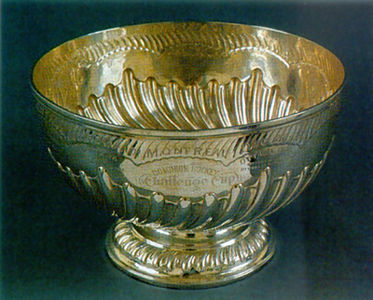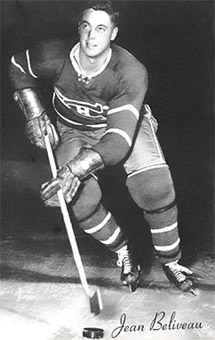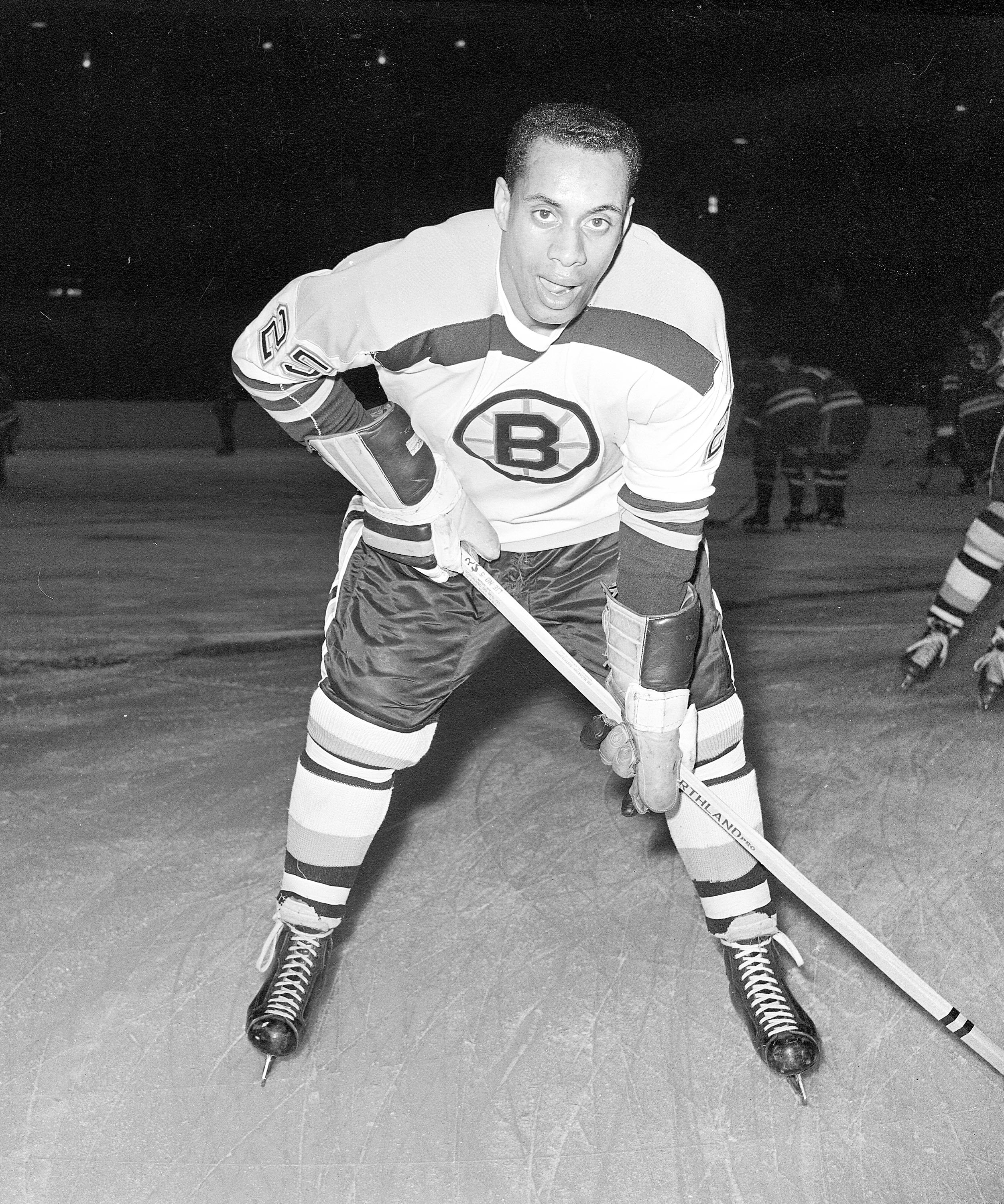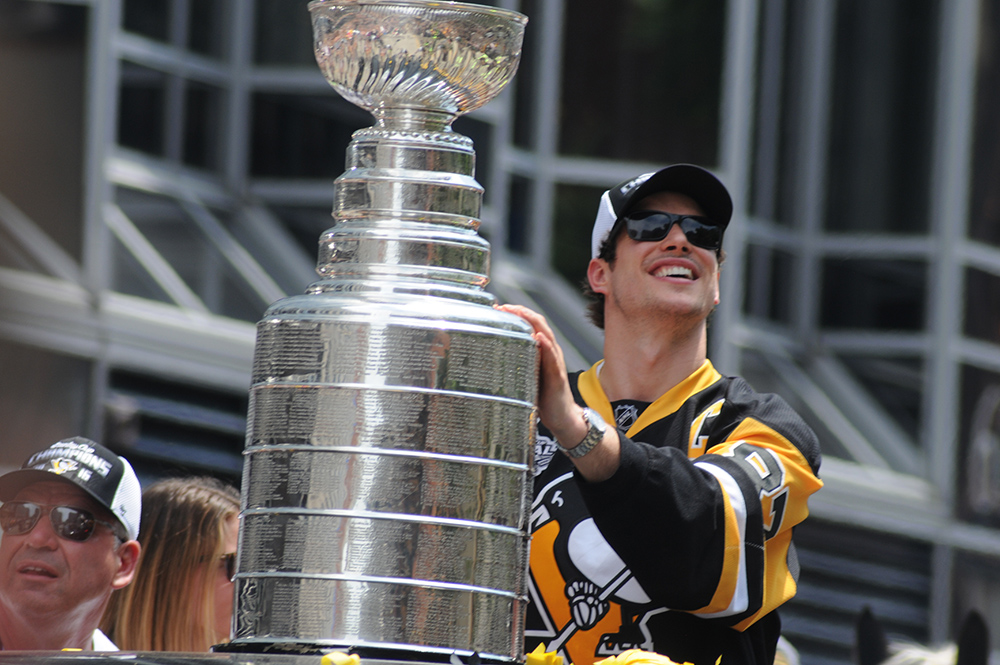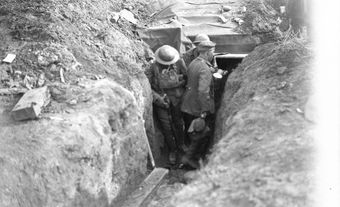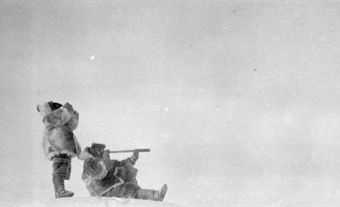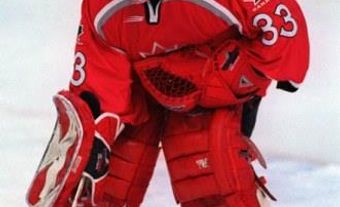Both the trophy and the league are Canadian in origin — not surprising, given the country’s love of hockey and the important role Canadians have played in its development. The Stanley Cup was donated in 1892 by Governor General Frederick Arthur Stanley , who had fallen in love with the game shortly after his arrival from Britain. Originally a trophy for the best amateur team in Canada, it’s now the top prize for teams in the NHL, the world’s premier professional hockey league.
The NHL had its start in Montréal, when it was founded by the owners of five Canadian professional teams in 1917. Since then, it has grown to 31 franchises (7 in Canada and 24 in the United States) and has its headquarters in New York City. Although Canada no longer dominates either the Stanley Cup or the NHL, Canadians still comprise approximately half of the league’s players, and are considered leaders both on and off the ice. Across the country, fans have cheered on their favourite teams and been thrilled to see Canadian players hoist the Cup in victory.
Lord Stanley’s Cup

In 1888, Sir Frederick Arthur Stanley was appointed Governor General of Canada. That winter, he watched the Montreal Victorias play the Montreal Amateur Athletic Association (MAAA). According to the Montreal Gazette, “Lord Stanley expressed his great delight with the game of hockey and the expertise of the players.”
On 18 March 1892, Stanley announced that he would donate a “challenge cup, which should be held from year to year by the champion hockey team in the Dominion of Canada.” He subsequently had a small silver bowl made in London, England, which arrived in Ottawa in early 1893. Originally called the Dominion Hockey Challenge Cup, it quickly became known as the Stanley Cup.
Challenge Era (1893–1915)

The Stanley Cup was first awarded to the Montreal Amateur Athletic Association (MAAA), whose affiliate team — the Montreal Hockey Club — was the 1892–93 champion of the Amateur Hockey Association of Canada. Tom Paton, goaltender of 1893 Montreal Hockey Club, was a founding member of the MAAA, and is credited with bringing ice hockey to Toronto.
Other teams could challenge the Stanley Cup champions at any point during the season. But that changed in 1912, when the Stanley Cup trustees decided that challenges could only come at the end of the champion’s regular season.
By 1909, the Stanley Cup was effectively a trophy for professional hockey teams, while amateurs played for the Allan Cup. In 1915, the National Hockey Association (NHA) and Pacific Coast Hockey Association (PCHA) decided that the Cup should be contested by their respective league champions, ending the challenge era.
The NHL: Early Years (1917–41)

The National Hockey League (NHL) was established in Montréal on 26 November 1917. The league succeeded the National Hockey Association (NHA), which had folded due to a dispute between team owners. (See Birth of the National Hockey League.)
The original NHL teams were the Montreal Canadiens, Montreal Wanderers, Ottawa Senators and Toronto Arenas (forerunner of the Toronto Maple Leafs). In 1918, the Arenas became the first NHL team to win the Stanley Cup. The Ottawa Senators dominated the 1920s, with six league titles and four Stanley Cup victories; however, the team folded in 1934.
In the first 25 years, the league underwent numerous changes in its composition, scheduling and playoff format. In 1924, the Boston Bruins became the first American club to join and by 1926, six of the 10 teams were from the United States. By 1927, the NHL was the premier professional hockey league in North America and effectively controlled the Cup.
The Original Six (1942–67)
The Great Depression and the Second World War took their toll on professional hockey and by 1942, there were six teams left in the NHL: the Montreal Canadiens, Toronto Maple Leafs, Boston Bruins, Chicago Black Hawks, Detroit Red Wings and New York Rangers. The league remained unchanged in this arrangement for 25 years. When six expansion teams were added to the league in 1967, the existing franchises became known as the “Original Six.”
The Toronto Maple Leafs, led by Walter “Turk” Broda, Syl Apps, Ted Kennedy and Max Bentley, were the dominant team of the 1940s, winning the Stanley Cup six times in 10 years. However, it was a Montreal Canadiens player, Maurice “Rocket” Richard, who became the first player to reach 50 goals in one season in the 1944–45 season. Chicago Black Hawk Bobby Hull would equal that record in the 1961–2 season, and then raise it to 54 (1965–66) and 58 (1968–69).
The outstanding team of the early 1950s was the Detroit Red Wings, led by Canadians Gordie Howe (who won the scoring championship five times and the Hart Trophy four times in the decade), Red Kelly, Ted Lindsay and Terry Sawchuk.
In the mid-1950s, the Montreal Canadiens built possibly the most powerful team in NHL history, with Maurice and Henri Richard, Bernie Geoffrion, Jean Béliveau, Jacques Plante, Dickie Moore, Doug Harvey and others. The Canadiens won the Stanley Cup five consecutive seasons (1955–56 to 1959–60), a league record.
Breaking the Colour Barrier in the NHL
On 13 March 1948, Larry Kwong of Vernon, British Columbia, became the first Chinese Canadian to play an NHL game, thereby breaking the colour barrier. Kwong played for the Rangers against the Montreal Canadiens at the Montreal Forum (the Rangers lost the game 3–2). He had only one minute of ice time in a single shift — not enough time to prove his worth to the team bosses. Kwong never played another NHL game.
In 1953, Fred Sasakamoose became the first Indigenous hockey player in the NHL. A former student of St. Michael’s Indian Residential School in Duck Lake, Saskatchewan, he played 11 games for the Chicago Black Hawks in the 1953–54 season.
On 18 January 1958, Willie O’Ree became the first Black hockey player to play an NHL game. O’Ree debuted with the Boston Bruins against the Canadiens at the Montreal Forum (the Bruins won 3–0).
NHL Expansion and WHA Merger (1967–79)

In 1967, six new US-based teams were added to the NHL: California (later Oakland) Seals, Los Angeles Kings, Minnesota North Stars, Philadelphia Flyers, Pittsburgh Penguins and St Louis Blues. Two years later, in 1969, Bobby Orr of the Boston Bruins became the first defenceman to win the Art Ross Trophy as leading scorer (he won it again in 1975). Orr revolutionized the role of the defenceman with his end-to-end rushes, his playmaking and his incredible scoring feats.
The Buffalo Sabres and the Vancouver Canucks joined the NHL in 1970, and the Atlanta Flames and New York Islanders in 1972. In 1974, with the addition of the Kansas City Scouts and Washington Capitals, the number of teams had reached 18. Three were based in Canada.
In 1979, the NHL merged with the World Hockey Association. The WHA had been founded in 1971, breaking the NHL’s monopoly on professional hockey. In its first season, there were many players in the league with NHL experience, including Bobby Hull, Bernie Parent, John McKenzie and Brian Conacher. When the WHA folded, the NHL gained the Winnipeg Jets, Edmonton Oilers, Québec Nordiques and Hartford Whalers.
The Montreal Canadiens remained the dominant team of the expansion era, winning eight championships between 1967 and 1979.
Wayne Gretzky and the Edmonton Dynasty (1980s)
In 1983–84, the Edmonton Oilers became the first ex-WHA team to win the Stanley Cup, ending a four-year reign by the New York Islanders. The high-scoring Oilers (with such stars as Mark Messier and Wayne Gretzky) captured the cup in four of the next six seasons.
Gretzky is regarded by many as one of the greatest hockey players of all time. His nickname, “The Great One,” attests to his on-ice abilities and impact in the sport. Gretzky's accomplishments are arguably unparalleled in any sport: he won the Hart Trophy (most valuable player) nine times, the Art Ross Trophy (scoring championship) 10 times, the Lady Byng Trophy four times and the Conn Smythe Trophy (outstanding player in a playoff) twice. He is the all-time leading scorer in the NHL with 2,857 points, and the only player to reach 2,000 career points, needing only 11 seasons to pass the record that took Gordie Howe 26 years to compile. He holds or shares an amazing 61 NHL records, including most goals (894) and most assists (1,963). Gretzky’s assists alone are enough to make him the league’s all-time leading point-scorer. He tallied 382 career points in the playoffs, almost 100 more than any other player. He was the leading scorer in six international tournaments, including all four Canada Cup tournaments in which he played.
The NHL in the 1990s
In the early 1990s, Mario Lemieux’s Pittsburgh Penguins became the dominant team, taking back-to-back Stanley Cups in 1990–91 and 1991–92, and winning a record 17 games in a row during the 1992–93 season.
At the end of the 1992–93 season, the Montreal Canadiens won its 24th Stanley Cup, defeating Wayne Gretzky’s Los Angeles Kings four games to one. That year’s playoff run was remarkable for the 10 straight overtime wins the Canadiens earned. They were led by the spectacular goaltending of Patrick Roy, who won the Conn Smythe Trophy for the second time in his career. It was the last time a Canadian franchise won the Stanley Cup.
In 1997, the Detroit Red Wings ended their Stanley Cup losing streak when they defeated the Philadelphia Flyers. Steve Yzerman was the first Red Wing to hoist the trophy since 1955. The following year he again won the Stanley Cup with the Red Wings, as well as the Conn Smythe Trophy and an appearance at the 1998 Olympic Winter Games in Nagano.
Breaking the Gender Barrier in the NHL (1992)

Goaltender Manon Rhéaume was a pioneer in women’s hockey. In the summer of 1992, Phil Esposito of the Tampa Bay Lightning invited her to attend training camp as one of eight goaltenders trying out for the team. The Lightning was a new NHL expansion team in a non-traditional hockey market, so the whole tryout was widely viewed as little more than a publicity stunt.
Yet Rhéaume survived the first round of cuts, and was given the first period of a pre-season exhibition match against the St. Louis Blues. She allowed two goals on nine shots, becoming the first woman to play in an NHL game. She also became the first woman to appear in any of North America’s major professional sports leagues.
Rhéaume also represented Canada in international women’s hockey. She was part of the World Championship women’s team in 1992 and 1994, and helped Team Canada win the Olympic silver medal in 1998, the first year that women’s hockey was included in the Olympic Winter Games.
Canada and the Stanley Cup
With 24 victories (including five straight wins from 1956 to 1960), the Montreal Canadiens have been the most successful team in Stanley Cup history, followed by the Toronto Maple Leafs franchise with 13 wins (including one as the Toronto Arenas in 1918 and one as the Toronto St. Patricks in 1922).
The last time a Canadian team won the Stanley Cup was in 1993, when the Montreal Canadiens defeated the Los Angeles Kings. The following season, the Vancouver Canucks made it to the finals, but were beaten by the New York Rangers. Since 2004, four Canadian franchises have qualified for the Stanley Cup final, only to be defeated by an American team. In 2004, the Calgary Flames lost to the Tampa Bay Lightning; in 2006, the Edmonton Oilers lost to the Carolina Hurricanes; in 2007, the Ottawa Senators lost to the Anaheim Ducks; and in 2011, the Vancouver Canucks lost to the Boston Bruins.
Canadian players have been well-represented on Cup-winning teams. This is hardly surprising, as about 50 per cent of NHL players hail from Canada. As in the past, Canadians continue to play crucial roles on and off the ice; most recently, Jonathan Toews led the Chicago Blackhawks to victory in 2010, 2013 and 2015, while Sidney Crosby hoisted the Cup in 2009 and 2016 as captain of the Pittsburgh Penguins.

 Share on Facebook
Share on Facebook Share on X
Share on X Share by Email
Share by Email Share on Google Classroom
Share on Google Classroom

